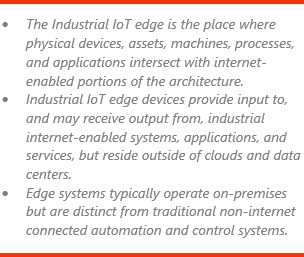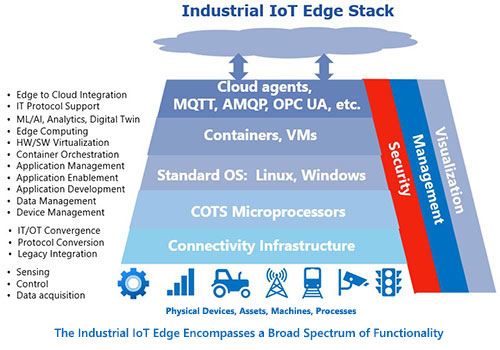




This guide includes both selection criteria and strategies for choosing the correct Industrial Internet of Things (IoT) Edge Software Platform technology and supplier.
 Industrial IoT edge software platforms perform infrastructure tasks such as device management, application development, enablement, and execution, hardware/software virtualization, and/or container orchestration, either together with cloud-based solutions or exclusively on-prem. The business value proposition of edge solutions varies widely, from pursuit of internal improvements in areas such as increased uptime (Industrial IoT) and/or production flexibility (Industrie 4.0) to inclusion in connected end products and pursuit of incremental service innovation.
Industrial IoT edge software platforms perform infrastructure tasks such as device management, application development, enablement, and execution, hardware/software virtualization, and/or container orchestration, either together with cloud-based solutions or exclusively on-prem. The business value proposition of edge solutions varies widely, from pursuit of internal improvements in areas such as increased uptime (Industrial IoT) and/or production flexibility (Industrie 4.0) to inclusion in connected end products and pursuit of incremental service innovation.
Supplier offerings can also correspond to this breadth of served applications, with provider legacies ranging from HMI and SCADA to cloud-native open source. It is therefore critically important to evaluate solutions not only for functional capabilities but also legacy supplier competencies, geographic and industry presence, and ecosystem participation, among many other criteria.
As cloud-based enterprise applications have become the norm, and cloud solutions themselves extend to the edge to access their source data, we increasingly find the edge solutions from the cloud providers are part of the selection process. IT organizations involved in the selection process also typically bring the cloud providers into the discussion. Customers evaluating edge solutions from the cloud players should take several factors into account, including response latency, security, amount of off-prem execution, and vertical domain expertise.

ARC understands the challenges that organizations face when making Industrial IoT Edge Software Platform choices. Through our years of research, ARC knows where additional insight may be needed, and the features that Industrial IoT Edge Software Platform solutions need to be fit for this purpose. This includes:
This ARC Selection Guide will help you select the best available Industrial IoT Edge Software Platform solution to meet your needs now and in the future.
ARC covers a broad spectrum of topics related to the Industrial Internet of Things. Technology Selection Guides and Global Market Research Reports are available for each of the topics discussed on this page: https://www.arcweb.com/technologies/industrial-iot-network-edge
For more information on this technology guide or to discuss how we can help you, please contact us.




